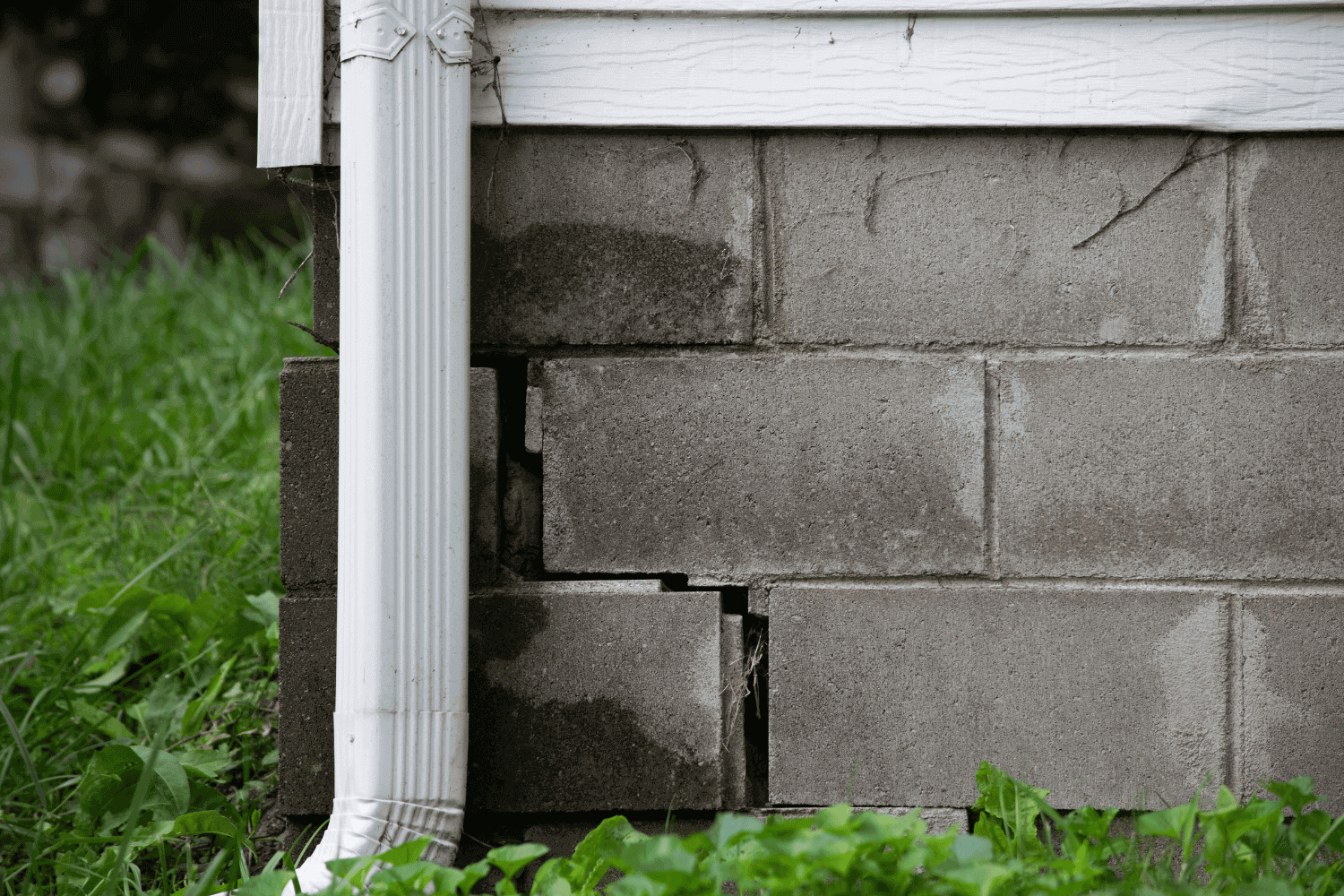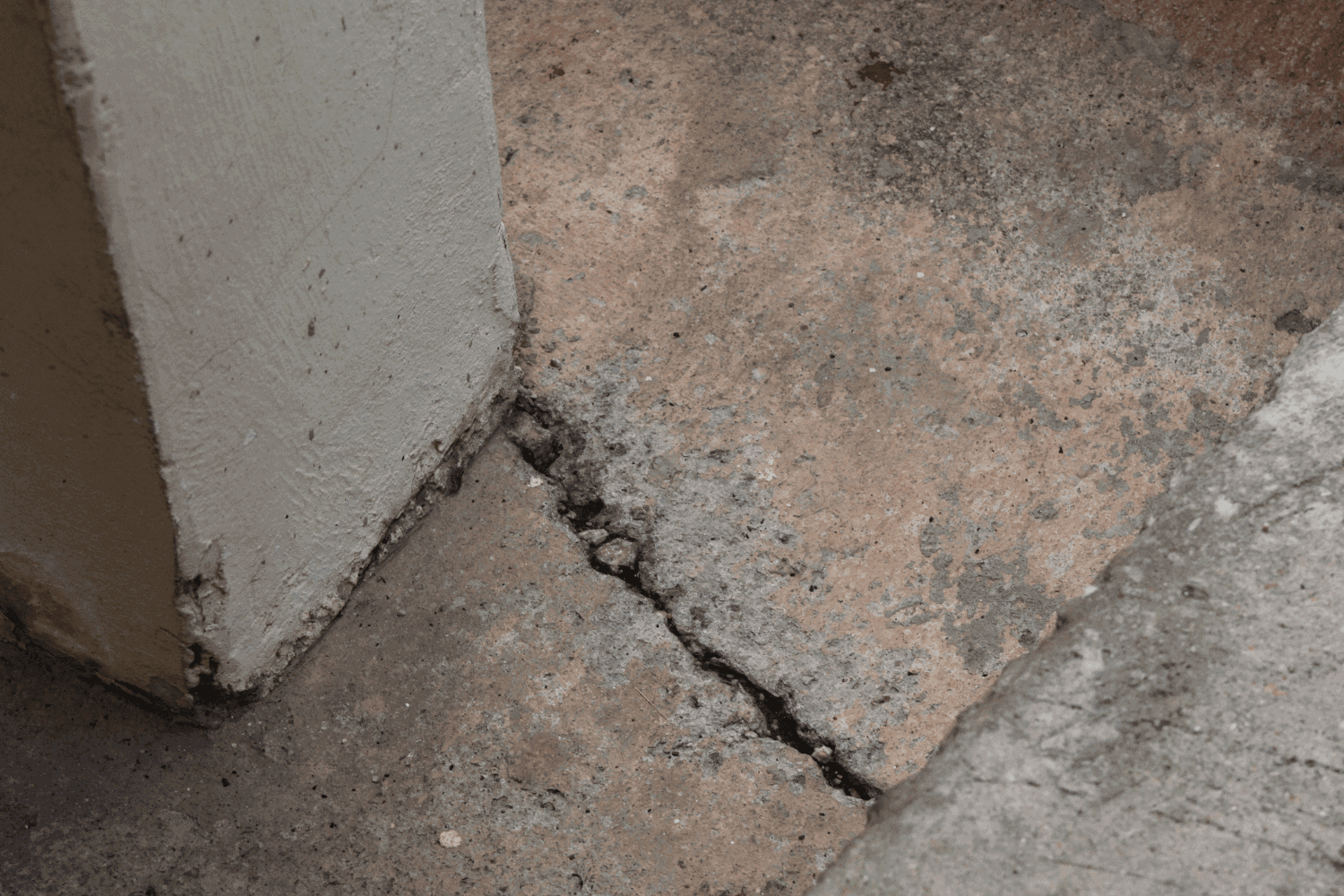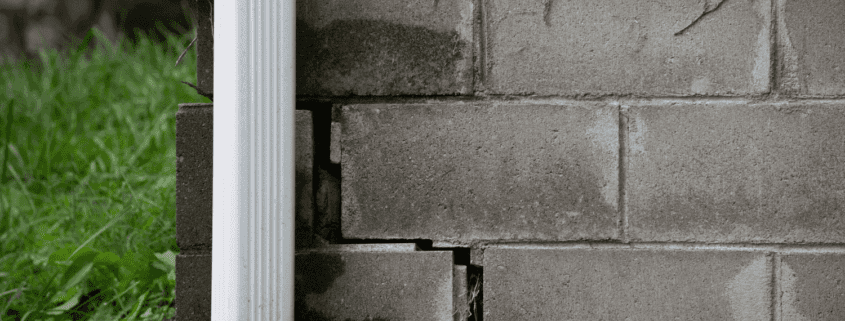Foundation Cracks to Be Concerned About: When to Take Action
Are you seeing cracks in your foundation and wondering which ones to be concerned about? It’s important to know which foundation cracks indicate serious problems. In this article, we’ll guide you through the types of foundation cracks to be concerned about, what they signify, and when to take action.
Key Takeaways
- Foundation cracks to monitor include horizontal cracks, vertical cracks wider than 1/4 inch, stair-step cracks, and diagonal cracks, each indicating varying levels of structural concerns.
- Early detection of foundation issues, such as sticking doors, uneven floors, and visible gaps, is crucial for preventing significant structural damage and costly repairs.
- Preventive measures, including proper grading, drainage, regular maintenance, and mindful landscaping, are essential to maintaining foundation integrity and avoiding future problems.
Types of Foundation Cracks That Require Attention

Foundation cracks come in various shapes and sizes, each indicating different levels of concern. The most common types to watch out for include horizontal cracks, vertical cracks wider than 1/4 inch, stair-step cracks, and diagonal cracks. These cracks can appear in a concrete foundation, block foundations, or basement walls, and each type can signify underlying structural foundation cracks that may worsen if left untreated.
Keeping track of these cracks is important as they can evolve into more serious structural problems if neglected. Horizontal cracks and hairline cracks, as well as those wider than 1/4 inch, in particular, require immediate attention as they often indicate serious structural problems.
Always keep an eye on any changes in the cracks, as widening gaps can be a sign of worsening foundation issues.
Horizontal Cracks
Horizontal cracks run left to right along foundation walls and are commonly found in both concrete and block foundations. These cracks are a significant red flag as they often indicate serious structural issues. The presence of horizontal cracks can suggest that the foundation walls are bowing inward due to soil pressure or hydrostatic pressure from excess water. This type of foundation crack can lead to water leakage and further compromise the structural integrity of your home if not addressed promptly.
If you spot horizontal cracks in your foundation walls, immediate action is required. These cracks can cause considerable foundation bowing and other major structural issues. Addressing horizontal cracks early can avert more extensive and expensive repairs later.
Stair-Step Cracks
Stair-step cracks, usually following mortar joints in block foundations, clearly indicate serious structural issues. These cracks form a pattern resembling a staircase, hence the name.
Stair-step cracks often indicate severe structural problems that require immediate attention to prevent further damage.
Vertical Cracks Wider Than 1/4 Inch
Vertical cracks wider than 1/4 inch indicate more than just settling; they suggest potential underlying structural problems. These cracks need a professional evaluation to determine the extent of the issue and the necessary repairs.
Ignoring such cracks can lead to more significant foundation damage and costly repairs in the future.
Diagonal Cracks
Diagonal cracks often indicate rotating walls due to structural failure. They can result from the natural curing process of concrete or differential settlement over time. Monitor these cracks closely, especially if you notice uneven or sloping floors, which can further indicate foundation movement.
Use a marble test to check the levelness of your floors if you suspect any foundation issues.
Identifying Structural Issues Early

Detecting structural issues early is crucial to prevent severe foundation problems. Signs of potential foundation issues include sticking doors and windows, uneven floors, and visible gaps between walls, ceilings, and floors. Identifying these signs early can help you address the root cause before it escalates.
Regular inspections and maintenance are essential for maintaining the structural integrity of your home. Implementing a foundation maintenance plan and conducting biannual inspections, especially after extreme weather events, can help identify new or changing cracks early. Promptly addressing these issues can save you from costly repairs and ensure your home’s safety.
Sticking Doors and Windows
Difficulty operating doors and windows can be an early sign of foundation movement or settlement. When doors and windows start sticking or become hard to open and close, it often indicates that the foundation is shifting, causing frames to become misaligned. This is a red flag for potential structural issues that need to be addressed.
Uneven Floors
Uneven floors are another common indicator of foundation problems. Poorly compacted soil before construction can lead to uneven settling, resulting in pressure and cracks. To check for uneven floors, place a marble on the floor and observe its movement.
If it rolls to one side, it indicates a slope, which could signify foundation issues.
Visible Gaps and Separation
Visible gaps between walls, ceilings, and floors clearly indicate foundation movement. These gaps suggest that the foundation may be shifting or settling, which can affect your home’s overall structural integrity.
Regularly monitoring these gaps is important, as any changes may require professional evaluation or repair to prevent further damage.
Causes of Foundation Damage

Understanding the causes of foundation damage helps in preventing future issues. The main causes include soil pressure, water-related problems, and frost heave. Poor drainage can lead to hydrostatic pressure, pushing against foundation walls and causing cracks. Effective water management and drainage solutions reduce the risk of foundation damage.
Foundation settlement can be influenced by factors such as construction materials, soil type, and water presence. Freezing and thawing cycles can also contribute to foundation cracks by causing soil expansion. Understanding these causes can help you take preventive measures to protect your foundation.
Soil Pressure and Settlement
Soil pressure and settlement significantly contribute to foundation damage. The expansion and contraction of clay soils due to moisture changes exert pressure on foundation walls, leading to cracks. Poor drainage and inadequate soil compaction can worsen these issues, causing uneven settling and structural problems.
Water-Related Problems
Excess water draining toward the foundation creates significant pressure against the walls, leading to structural issues. Poor drainage can cause water to accumulate around the foundation, resulting in shrinkage and wet non-structural cracks.
Effectively managing water runoff is important to prevent these problems.
Frost Heave
Frost heave occurs due to the freezing and thawing of soil around the foundation. These cycles cause soil to expand, creating pressure on the foundation and resulting in cracks.
Repeated freezing and thawing can significantly impact the foundation’s structural integrity, so it’s important to address any resulting cracks promptly.
Repairing Foundation Cracks

Repairing foundation cracks promptly prevents further structural damage. Various methods can be used depending on the type and severity of the crack. Expanding polyurethane is highly effective for sealing cracks due to its waterproofing and flexibility properties. Choosing the right repair method can significantly impact the longevity and effectiveness of the repair.
Addressing foundation cracks as soon as they are detected can save you from more extensive and costly repairs in the future. Understanding how to fix foundation cracks and selecting the foundation crack repair method that best suits your specific needs is crucial to prevent foundation cracks.
Epoxy Injection
Epoxy resin injections are commonly used to seal minor foundation cracks and prevent water intrusion. This method is particularly effective for vertical cracks and can cost between $500 to $900 for professional repair.
Regularly monitoring vertical cracks and addressing them with epoxy injection can prevent further structural issues.
Hydraulic Cement Application
Hydraulic cement is a fast-setting material ideal for repairing leaking cracks in foundations. Clean the area around the crack, mix the cement according to the instructions, and press it firmly into the crack to ensure a secure seal.
As it cures, hydraulic cement expands, blocking water from seeping through and providing a durable, watertight seal.
Carbon Fiber Reinforcement
Carbon fiber reinforcement strengthens foundation walls, particularly those compromised by structural issues. Carbon fiber strips bond the distance between cracks, increasing the structural strength of the foundation wall. These reinforcements are ten times stronger than steel and provide a lightweight yet highly effective solution for preventing further damage.
Preventing Future Foundation Issues

Preventing foundation issues is better than dealing with costly repairs. Most foundation problems arise from water-related issues, leading to soil swelling or shrinkage that destabilizes the foundation. Implementing preventive measures helps maintain your foundation’s integrity and avoid future problems.
Proper grading and drainage solutions, regular maintenance, and smart landscaping choices are key to preventing foundation issues. Taking these steps protects your home and ensures its structural stability.
Proper Grading and Drainage Solutions
Proper grading around your home should guide water away from the foundation, preventing soil expansion. Create a slope of at least one inch per foot for the first 5 to 10 feet away from the foundation.
Ensure that soil does not contact the siding or wood of the house, with at least four inches of the foundation visible above the soil.
Regular Maintenance Tips
Regular maintenance is essential for identifying potential issues early. Inspect the foundation for new or changing cracks and address minor issues promptly to prevent them from developing into significant problems.
If you spot water or moisture from a crack, act quickly to prevent further damage.
Landscaping Considerations
Landscaping plays a vital role in preventing foundation issues. Keep plants and trees a safe distance from the foundation to prevent root damage and moisture accumulation. Plant trees at least 15 feet away from the foundation to avoid these problems.
Summary
In conclusion, understanding the types of foundation cracks, identifying early signs of structural issues, knowing the causes of foundation damage, and implementing preventive measures are crucial for maintaining your home’s structural integrity. By addressing foundation problems promptly and effectively, you can ensure the safety and stability of your home. Remember, A&M Home Services is here to help with reliable, affordable, and effective foundation repair solutions.
Frequently Asked Questions
What are the common types of foundation cracks to watch out for?
It’s important to watch for horizontal cracks, vertical cracks wider than 1/4 inch, stair-step cracks, and diagonal cracks, as they may indicate underlying structural issues. Monitoring these types of cracks can help ensure the integrity of your foundation.
How can I identify early signs of structural issues in my home?
To identify early signs of structural issues in your home, be vigilant for sticking doors and windows, uneven floors, and visible gaps between walls, ceilings, and floors. These indicators can help you address potential problems before they worsen.
What causes foundation damage?
Foundation damage is primarily caused by soil pressure, water-related issues, and frost heave, with poor drainage and freeze-thaw cycles also playing significant roles. Addressing these factors early can help prevent serious structural problems.
What are some effective methods for repairing foundation cracks?
Effective methods for repairing foundation cracks include epoxy injection to seal small cracks, applying hydraulic cement for wider gaps, and using carbon fiber reinforcement for added support. These solutions can help ensure the integrity of your foundation.
How can I prevent future foundation issues?
To prevent future foundation issues, ensure proper grading and drainage around your home, maintain regular landscaping, and keep plants and trees at a safe distance from the foundation. Taking these proactive steps is essential for maintaining a stable foundation.
 574-318-3326
574-318-3326






